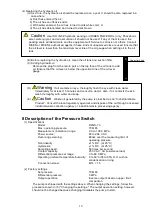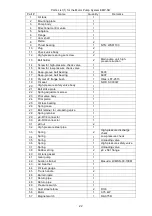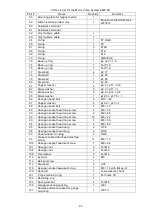
9
4 Safety Cautions for Use
Warning
Before applying pressure, the blind plug of the oil output port must be
taken off. Apply pressure after the high pressure fittings and accessories (Hydraulic hose,
Coupler) are mounted.
Warning
The maximum output pressure of these pumps is 70 MPa. For safety,
each pump is factory fitted with a high pressure safety valve adjusted to 73 MPa. Do not allow
the safety valve to be adjusted to a level higher than 73 MPa. Where the pump is fitted with a
pressure switch, set this at 70 MPa or less.
Warning
When using this pump with hydraulic equipment of which working
pressure is less than 70 MPa, lower the setting of the high pressure safety valve and adjust the
pressure switch to match the working pressure of the equipment. Failure to lower settings
could result in the equipment damage. For a method of adjustment, refer to page 18 “Adjusting
the High Pressure Safety Valve".
Warning
Ensure power is switched off before conducting electrically related
maintenance or inspection.
Warning
Ensure to use oil at temperatures between 5° and 60° Celsius. The use
of oil that exceeds 60° Celsius will shorten the lifespan of the hydraulic equipment and might
cause personal injury if heated oil is touched. Install an oil cooler to lower oil temperature for
safety.
Caution
Use ISO VG32 hydraulic working oil (RIKEN POWER OIL) only.
Phosphoric ester, water-glycol, and w/o emulsion oil should not be used; if any of them is used,
the packing seals will deteriorate and the equipment fail due to corrosion or others. Consult
RIKEN or RIKEN’s authorized agents if these kinds of unapproved oils are used. Ensure that
the oil level is lower than the maximum level line of the oil gauge when adding oil to the oil
tank.
Caution
Do not use the high pressure safety valve as a relief valve. Install a
separate relief valve if it is necessary to perform continuous relief.
Most prevalent reason of hydraulic pump failures is caused by dirt entry. Keep the pump and
other ancillary equipment clean to prevent foreign matter from entering them.
Replace the hydraulic oil at least once a year.
Before exciting a solenoid of the directional control valve (ESW-4H), ensure that the other
solenoid is demagnetized. Do not magnetize both solenoids simultaneously. Do not keep the
solenoid energized for longer than 1 minute. Doing so may cause hydraulic locking,
immobilizing the spool.
Ensure that the switching frequency of the directional control valve (ESL-4S and ESW-4H)
does not exceed 20 cycles per minute (one cycle means a set of operations in which each of
the right and left solenoid is turned on and off).
For high-voltage specifications or different operation voltage, please consult us.
Do not hit or damage the oil level gauge. If the oil level gauge is broken, the hydraulic oil
comes out.
When installing a pressure gauge to the pump using a solenoid directional valve, use a gauge
damper (GD-70) to protect the gauge.
In order to return the hydraulic oil through the return port
located at the top face of the oil tank, attach a fitting and pipe to
the port so that the returned oil will be poured into the oil in the
tank at the point lower than the minimum level line of the oil
level gauge. Without a pipe, air enters the hydraulic oil and the
pump suctions the air, which makes it unable to raise the
pressure. The fitting and pipe are available from us. Please
order them if necessary.
Fitting
Return port
Steel
pipe














































